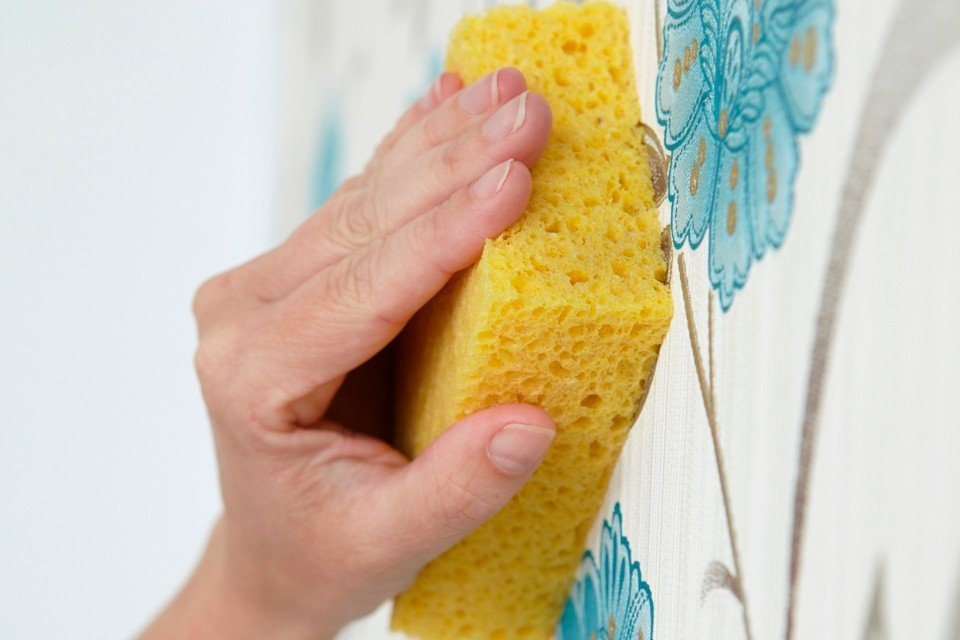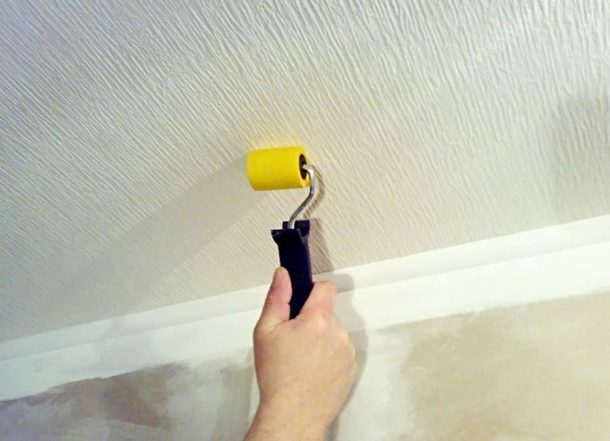Content
- Types of drawing on wallpaper and features of its combination
- What is rapport
- Features of gluing wallpaper with a pattern
- Calculation of wallpaper without fitting the picture
- Calculation with fitting the picture
- Wall surface preparation
- Marking the wall and placing a large picture
- Drawing without offset
- Offset drawing
- How to glue wallpaper with a picture in the corner
- Summary
It would seem that it can be difficult in wallpapering? Cut, paste and glue, that's all. That's just with this approach, you can easily spoil for so long the selected material or get completely not the result that was planned. It turns out that the process of gluing with your own hands has many subtleties, especially when it comes to wallpaper with a pronounced pattern. Before starting work, you will have to find out what rapport is, how to cut the wallpaper so that the image on the adjacent stripes matches, and finally, how to properly wallpaper the picture.

Types of drawing on wallpaper and features of its combination
Images on canvases can be divided into several types, which will differ not only in appearance, but also on the principle of working with them.
- Solid color pattern. This can be attributed to the canvas without any image or pronounced pattern, for example, speckled, polka-dot, as well as with texture. Does not need to dock image elements, which means that working with such canvases will be easier.
- Abstract - wide strokes, stains, spots, often arranged in a chaotic manner. Such wallpapers usually do not require fitting stripes.
- Geometric - lines, squares, circles, rhombuses, small and large. Most likely, a combination of elements will be required.
- Strip. Vertical usually does not require adjustment, for horizontal you need precise matching.
- Vegetable - leaves, stems, branches, flowers. As a rule, they need fitting elements of the pattern.
- Classic - monograms interwoven with each other and forming a single whole on the wall surface. Docking is required.
- Ornamental - hieroglyphics, ornament, motifs of Persian carpets, etc. The need for adjustment depends on the nature of the picture.

- Plain wallpaper

- Abstraction

- Geometric pattern

- Strip

- Plant drawing

- Ornament

- Monograms
What is rapport
Rapport (step of the picture) is the repetition of the image on one strip of wallpaper. Information about it is usually found on the label of the roll.

Rapport is of two types:
- height - repeat the pattern along the entire length of the wallpaper sheet;
- lateral - duplication of the pattern along the width of the strip.
The first type of rapport (the height of the repeating pattern) will participate in the calculations, therefore it is he who is mentioned below.
USEFUL INFORMATION:Everything you need to know about combining wallpapers

Knowing the ratio of the height of the rapport and the height of the room, you can easily calculate how much you will have to cut off from each strip to make the picture fit.
Features of gluing wallpaper with a pattern
Working with print wallpapers has its own nuances. Knowing these features will help to avoid errors, for example, inconsistencies in the pattern.
- When buying material, it is taken into account that the amount of waste due to the need to combine the pattern will increase. Therefore, you need to take rolls with a margin. Knowing the rapport pitch, you can calculate the required number of tubes most accurately.
Tip. To significantly reduce the proportion of waste, it is recommended to cut pieces from different rolls when selecting a pattern.
- For perfect image alignment, be sure to leave allowances of a few centimeters at both ends of the strip.
- During gluing, special attention is paid to the joints.
Calculation of wallpaper without fitting the picture
Some paintings, for example in a vertical strip or in a speck, do not require fitting the picture.

Consider the calculation procedure using an example of a room with the following parameters: perimeter - 18 m, ceiling height - 2.5 m. Standard roll width - 53 cm, length - 10 m.
- The perimeter of the room is divided by the width of the wallpaper tube and we get the number of stripes. The result is rounded up (18: 0.53 = 34 with rounding).
- The length of the canvas is divided by the height of the room (10: 2.5 = 4 stripes). A possible offset of the cuts will be hidden by skirting boards near the floor and ceiling.
- To obtain the required number of rolls, divide the first result into the second (34: 4 = 8.5). We round up, we get 9 tubes.
Attention! In the case of gluing wallpaper with an overlap image, the resulting material width should decrease by two to three centimeters.
Calculation with fitting the picture
Wallpaper with a complex or large ornament requires adjustment, so the calculation will be different. The length of the strip should exceed the height of the room and be a multiple of the rapport (step of the figure).

Let us analyze the calculation procedure for the same room (perimeter - 18 m, ceiling height - 2.5 m). Roll width - 53 cm, length - 10 m, rapport - 38 cm.
- The length of the strip is calculated as follows. Divide the height of the room by the value of the rapport (2.5: 0.38 = 6.6). We round the resulting number to the nearest integer. In our case, it will be 7. Multiply by the obtained number the value of the image step (0.38 × 7 = 2.66 m). Now we divide by the available result the length of the roll (10: 2.66 = 3.8). Round to an integer, but down. It turns out that the roll is enough for 3 cuts, the rest is forced losses.
- Next, we calculate the number of tubes. First we find the number of stripes, for this we divide the perimeter by the width of the roll, as in the first case (18: 0.53 = 34 with rounding). Now we divide the obtained value by the number of stripes in the tube (34: 3 = 12 with rounding). Our room will need 12 rolls.
USEFUL INFORMATION:How to mount a TV on a drywall wall
As you can see, the difference between the number of wallpapers with a picture without combining and an image that needs to be adjusted is as much as 3 tubes.
Wall surface preparation
Preliminary work before gluing wallpaper with a pattern does not differ from standard preparation. The algorithm is as follows:
- Clean the surface of old coatings. How to do it right, read here.
- Apply a primer coat.
- Putty surface (if there are chips, cracks, bumps).
- Allow the walls to dry.
- Scrub it with a sandpaper or sanding net.
- Primer again.

About how drywall is prepared for wallpapering, it is written in detail here.
Marking the wall and placing a large picture
Often when sticking wallpaper you have to deal with walls and ceilings that have a slope. The marking method will depend on the degree of curvature at the corners. To begin with, you should measure the height of the room in each of them.
- With a slight slope, you need to mark the walls with a plumb line or a laser level to maintain a strict vertical.
- In case of a difference of more than 6–8 cm, it is recommended to stick the wallpaper with a pattern perpendicular to the ceiling, without focusing on the plumb line. In such a situation, the stripes perfectly aligned vertically will appear to be blocked up due to the visual effect created by the inclined surface.
Important! Wallpaper with vertical stripes adheres strictly according to the plumb line regardless of the degree of curvature of the ceiling surface.
- If the ceiling is uneven, a wallpaper with a large pattern should be glued so that for the first time the volumetric image element is located as far as possible from the top of the wall. Otherwise, the curvature of the surface will be immediately apparent.

Even with correctly done markings, the pattern of the last strip may not converge with the first because of the curvature of the surfaces. Therefore, when deciding where to start gluing material with a pronounced image, it is better to choose the most inconspicuous place in the room.
Drawing without offset
When gluing wallpapers, the image on which does not need to be displaced, we proceed as follows:
- Using the calculations, we cut the roll into strips whose length is a multiple of the rapport step and slightly exceeds the height of the room.
- Sticking wallpaper with a large pattern is necessary taking into account the rapport. All stripes should start with the same pattern, for this you need to select the canvas so that the pattern matches. If you use to combine strips from the second roll, there will be much less scraps.
- Thin wallpapers are glued with overlap. You need to start work from the wall close to the window, otherwise overlaps will be noticeable.
- The first lane should be positioned from the drawn vertical line near the corner (along the plumb line).
- After the opposite wall is glued to the corner, we return to the first vertical line, which served as our reference point, and continue to glue the wallpaper from it.
USEFUL INFORMATION:How to align the walls in the bathroom with tiles: how to align the walls with tiles

Offset drawing
It happens that the image elements in all the stripes on the edges do not coincide in height and therefore the wallpaper is glued with an offset image. If you take adjacent strips from one roll, you get a huge overrun. We use a trick that will help save material.
We take 2 tubes and unwind them on the floor. Combine the canvas from the 2nd roll with a strip of the 1st. We lay out the cut sheets in two piles. Further, the pattern on the wallpaper of two rolls will match. When gluing, strips from both stacks alternate: the first sheet is from stack No. 1, the second is from No. 2, the third is again No. 1, etc.

How to glue wallpaper with a picture in the corner
When gluing wallpaper with a picture in the corner, image distortion often occurs. to avoid this, follow a few rules.
- It is necessary to leave an overlap of the canvas on an adjacent wall.
- The resulting joint is masked at the top of the corner.
- The edges of the strips should be glued exactly along the line drawn up to this. The edge of the second canvas is cut in the corner.

Distortion of the picture in the corners can be completely avoided, most likely, it will not be possible, but errors can be minimized.
Summary
Gluing wallpaper with a large or medium size image that requires combination is more difficult than plain canvas. Another drawback of this kind of material is its high consumption. But if you understand all the intricacies of the calculation and gluing methods described above, you can not only easily cope with this work, but also save material by reducing the amount of waste.
If something in the article seemed incomprehensible, write in the comments. We will try to answer all the questions.


